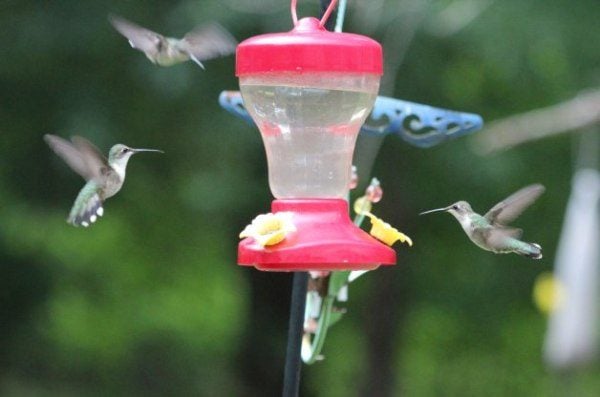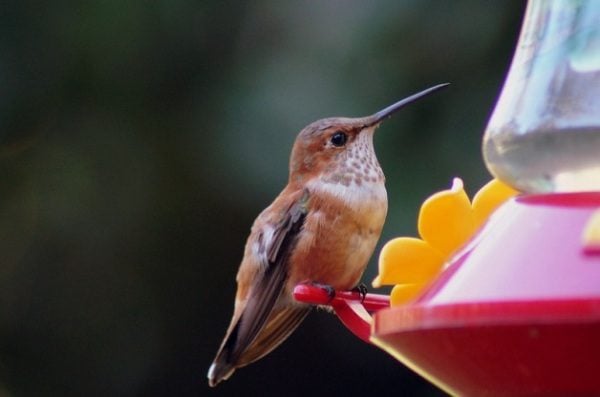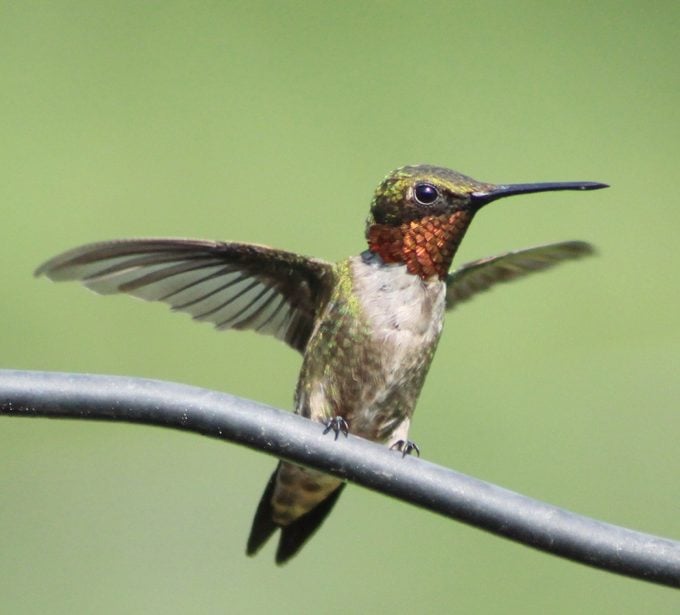Attract More Hummingbirds for Less Money
Updated: Jan. 03, 2024
Save time and money when feeding and attracting hummingbirds with these simple tips and tricks. Your wallet will thank you!
Attracting hummingbirds is a rewarding and fun hobby, but the costs can add up if you’re not careful. Save yourself some money and time when feeding hummingbirds with these proven tips from Birds & Blooms editors and readers. Plus, discover what you can use to feed and attract hummingbirds besides sugar water.
Discover jaw-dropping facts about hummingbirds.
On This Page
Save Money on Feeding Hummingbirds

- Make your own sugar water: There’s no need to buy expensive pre-made hummingbird nectar at the store. Make your own with 4 parts water to 1 part sugar. Boil it, cool it, and store any leftovers in the fridge for up to a week.
- Skip the red food coloring – it’s not necessary and may be harmful to birds. Plus, never add these ingredients to the sugar water!
- Place hummingbird feeders wisely: If you place your feeders in the shade, you’ll get less algae growth, so you won’t have to change the homemade nectar nearly as often.
- Stick with simple feeders: Don’t be tempted by all the fancy, expensive hummingbird feeders you see. The basic models work just fine when attracting hummingbirds.
- You can make your own feeder from pretty much anything that holds water. Clean and sanitize an old wine bottle. Attach a hummingbird feeding tube, then hang it upside down in your garden. Inexpensive, attractive, and great for feeding hummingbirds!
What Else Can I Feed Hummingbirds Besides Sugar Water?

- Plant their favorite flowers: Determine which flowers are best for attracting hummingbirds. Grow more of those instead of experimenting with new expensive plants that may not work for you. A packet of annual flower seeds can go a long way for just a few dollars.
- Add native perennial flowers to your yard, which grow back year after year and require less water and maintenance. As a bonus, native plants attract beneficial bugs. As the hummingbirds drink nectar, they might also grab a bug or two.
- Lure hummingbirds with moving water, such as a mister, bubbler or small fountain in a birdbath.
Save on Hummingbird Feeder Maintenance

- Keep out ants: reader Bonnie Hutson of Independence, Missouri, sent this clever idea. Drill a hole in the center of a peanut butter lid. Attach a J bolt to one side and an eyebolt to the other. You’ll have an instant ant moat to place between your feeder and the hook it hangs from!
- Clean hummingbird feeders easily: Hummingbird feeders can be notoriously hard to clean well, with all the nooks and crannies for mold to hide in. About once a week, dispose of any remaining hummingbird nectar, then fill your feeder halfway with water and add a splash of vinegar. Throw in a bit of rice, sand, or unpopped popcorn kernels and shake well. Vinegar kills germs safely, while the textured items scrape dirt away. Rinse well for a cleaner feeder!
- Reuse cleaning tools: Instead of buying brushes specially made for cleaning hummingbird feeders, just use an old toothbrush or some pipe cleaners. These tools are perfect for cleaning those hard-to-reach spots.
Discover natural ways to keep bees and wasps away from hummingbird feeders.
More Tips to Attract Hummingbirds on a Budget

- Red accents: A little red goes a long way in attracting hummingbirds, especially when it’s early in the season. Real red flowers are ideal, but you can also add ribbons, bows, pieces of an old scarf, or artificial flowers to draw them in. Attach them to the top of the pole or feeder.
- Hummingbird perches: Hummingbirds need to rest too! Male hummingbirds especially love a place to perch near a feeder. Hang a few branches with the leaves stripped off from the pole, or add a coat hanger or two from trees nearby. Or build a DIY hummingbird swing.
- Nest for less: Go ahead and let your dandelions and milkweed go to seed. The hummingbirds will use the fluffy fibers to line their nests.
- Kick back and relax: Once you’ve created your ideal hummingbird habitat, be sure to take time to sit outside and take in the sights and sounds. Take your morning coffee outside, eat lunch under the trees, or enjoy the evening breeze in your garden. Hummingbirds will provide the rest of the show!
Next, learn about the 15 types of hummingbirds found in the United States.




















